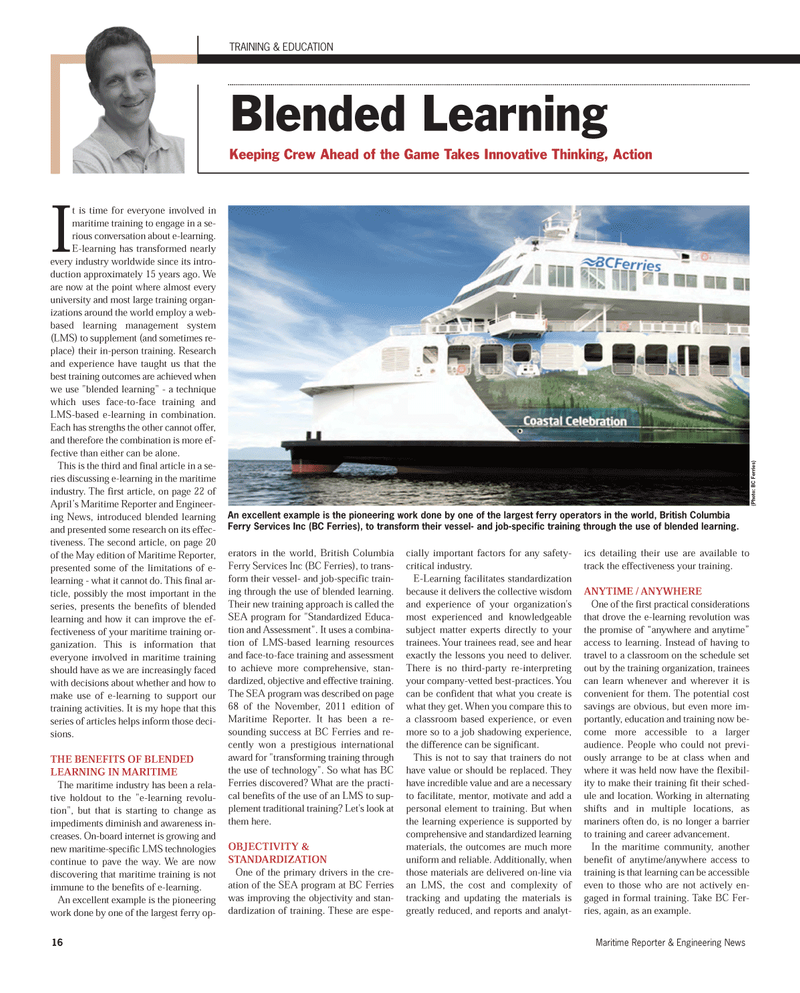
Page 16: of Maritime Reporter Magazine (June 2012)
Annual World Yearbook
Read this page in Pdf, Flash or Html5 edition of June 2012 Maritime Reporter Magazine
16Maritime Reporter & Engineering News It is time for everyone involved in maritime training to engage in a se- rious conversation about e-learning. E-learning has transformed nearlyevery industry worldwide since its intro- duction approximately 15 years ago. We are now at the point where almost every university and most large training organ- izations around the world employ a web- based learning management system(LMS) to supplement (and sometimes re-place) their in-person training. Researchand experience have taught us that the best training outcomes are achieved when we use "blended learning" - a techniquewhich uses face-to-face training and LMS-based e-learning in combination.Each has strengths the other cannot offer, and therefore the combination is more ef-fective than either can be alone. This is the third and final article in a se- ries discussing e-learning in the maritimeindustry. The first article, on page 22 of April?s Maritime Reporter and Engineer- ing News, introduced blended learning and presented some research on its effec- tiveness. The second article, on page 20 of the May edition of Maritime Reporter, presented some of the limitations of e-learning - what it cannot do. This final ar- ticle, possibly the most important in theseries, presents the benefits of blended learning and how it can improve the ef- fectiveness of your maritime training or- ganization. This is information that everyone involved in maritime training should have as we are increasingly faced with decisions about whether and how to make use of e-learning to support our training activities. It is my hope that this series of articles helps inform those deci-sions. THE BENEFITS OF BLENDEDLEARNING IN MARITIME The maritime industry has been a rela-tive holdout to the "e-learning revolu- tion", but that is starting to change as impediments diminish and awareness in- creases. On-board internet is growing and new maritime-specific LMS technologies continue to pave the way. We are now discovering that maritime training is not immune to the benefits of e-learning. An excellent example is the pioneering work done by one of the largest ferry op- erators in the world, British Columbia Ferry Services Inc (BC Ferries), to trans-form their vessel- and job-specific train- ing through the use of blended learning.Their new training approach is called the SEA program for "Standardized Educa-tion and Assessment". It uses a combina- tion of LMS-based learning resourcesand face-to-face training and assessment to achieve more comprehensive, stan- dardized, objective and effective training. The SEA program was described on page 68 of the November, 2011 edition of Maritime Reporter. It has been a re- sounding success at BC Ferries and re-cently won a prestigious international award for "transforming training through the use of technology". So what has BCFerries discovered? What are the practi- cal benefits of the use of an LMS to sup- plement traditional training? Let's look atthem here.OBJECTIVITY & STANDARDIZATION One of the primary drivers in the cre- ation of the SEA program at BC Ferrieswas improving the objectivity and stan- dardization of training. These are espe- cially important factors for any safety- critical industry. E-Learning facilitates standardization because it delivers the collective wisdom and experience of your organization's most experienced and knowledgeable subject matter experts directly to your trainees. Your trainees read, see and hear exactly the lessons you need to deliver. There is no third-party re-interpretingyour company-vetted best-practices. You can be confident that what you create is what they get. When you compare this to a classroom based experience, or even more so to a job shadowing experience, the difference can be significant. This is not to say that trainers do nothave value or should be replaced. They have incredible value and are a necessary to facilitate, mentor, motivate and add a personal element to training. But whenthe learning experience is supported by comprehensive and standardized learning materials, the outcomes are much moreuniform and reliable. Additionally, when those materials are delivered on-line via an LMS, the cost and complexity of tracking and updating the materials isgreatly reduced, and reports and analyt-ics detailing their use are available to track the effectiveness your training. ANYTIME / ANYWHERE One of the first practical considerations that drove the e-learning revolution was the promise of ?anywhere and anytime? access to learning. Instead of having to travel to a classroom on the schedule set out by the training organization, trainees can learn whenever and wherever it is convenient for them. The potential cost savings are obvious, but even more im- portantly, education and training now be- come more accessible to a larger audience. People who could not previ- ously arrange to be at class when andwhere it was held now have the flexibil- ity to make their training fit their sched- ule and location. Working in alternating shifts and in multiple locations, asmariners often do, is no longer a barrierto training and career advancement. In the maritime community, another benefit of anytime/anywhere access to training is that learning can be accessibleeven to those who are not actively en- gaged in formal training. Take BC Fer- ries, again, as an example. TRAINING & EDUCATION Blended LearningKeeping Crew Ahead of the Game Takes Innovative Thinking, Action An excellent example is the pioneering work done by one of the largest ferry operators in the world, British Columbia Ferry Services Inc (BC Ferries), to transform their vessel- and job-specific training through the use of blended learning. (Photo: BC Ferries)MR June12 # 2 (9-16):MR Template 6/12/2012 8:43 AM Page 16

 15
15

 17
17
